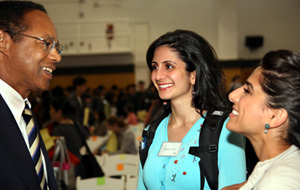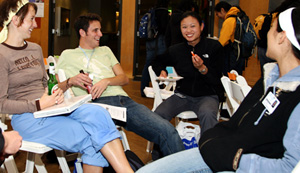
First-year dental student Shirin Mullen looked at top-ranked dental schools across the nation before deciding to attend UCSF.
The native of Texas says she chose UCSF because of its "great reputation" as a health sciences university. Among other selling points were the excellent faculty, the prospects of living in San Francisco and the diversity of the campus community, Mullen says.
And although the high cost of living and tuition were also factors in her final decision, Mullen says simply, "You can't put a price on experience."
During her third day at UCSF, Mullen was among new students from across all four professional schools, as well as those studying physical therapy and dietetic interns from UCSF Medical Center, to participate in the second annual Interprofessional Education Day at UCSF on Sept. 19.
For Mullen, the concept of cross-school communication and collaboration makes sense. "Dental health plays a role in the overall health of a person," she says. "We're going to have to interact with each other, communicating with physicians and nurses, to treat patients. It's good to start developing relationships right now."
A campus devoted exclusively to the health sciences, UCSF has an enormous opportunity to take the lead in interdisciplinary education, campus leaders say.
Embracing Interdisciplinary Education
In fact, fostering innovation and collaboration is the first priority listed in the UCSF Strategic Plan, which specifically calls for ensuring that "students and trainees are immersed in a culture that embraces interdisciplinary, interprofessional and transdisciplinary educational programs."
In welcoming students to Interprofessional Education Day, Eugene Washington, executive vice chancellor and provost, explained the importance of interdisciplinary teamwork in patient care. A video is posted of that event is
posted here.

Executive Vice Chancellor and Provost Eugene Washington greets students at the second annual Interprofessional Education Day on Sept. 19.
"Communication and collaboration are central to high-quality patient care, and particularly when it comes to patient safety," Washington said. "This program today is not just an isolated exercise. It really cuts in many ways to the core of what we see at UCSF as our future. That's this idea of fostering collaboration and innovation."
Robert Wachter, professor of medicine, chief of the Medical Service and chair of the Patient Safety Committee at UCSF Medical Center, also believes improved human interaction among practitioners is critical in ensuring patient safety. "Placing a greater emphasis on interdisciplinary collaboration is pretty unique. Hospitalists recognize that providing high-quality, safe care is a team sport," he said.
Wachter also spoke to students during Interprofessional Education Day. Each student received a copy of his best-selling book,
Internal Bleeding, which highlights how medical mistakes occur. Wachter also has been working to foster improved collaboration among the health care team.
Recently, the Medical Service hosted a program supported by a grant from the Gordon and Betty Moore Foundation to the UCSF schools of nursing, pharmacy and medicine to train 400 nurses, doctors, pharmacists, social workers and others in teamwork and collaboration. Feedback has been very positive from this experience and has led to improved communication and collaboration, Wachter notes.
Calling for a New Model of Care
The idea for interdisciplinary education is called for in national reports, including those by the Institute of Medicine, the National Academy of Sciences and professional societies.
At UCSF, interdisciplinary education has been the focus of a group of 23 individuals representing a cross-section of the campus, including associate deans from all four schools, as well as representatives from the Work~Life Resource Center, Physical Therapy department and the Office of Student Life. Together, they organized the Interprofessional Education Day. This year, the deans elected UCSF School of Nursing Dean Kathleen Dracup to address the students on their behalf.
Dracup urged first-year students to rise to the challenge of breaking through traditional barriers - the bureaucratic, stereotypical and hierarchical nature of working in hospitals - to work as a highly functioning team to provide excellent patient care.
"Stereotypes are the greatest challenge of all to creating a healthy work environment," Dracup said. "Since we've all been educated in our disciplines and each discipline has its own unique tradition and metrics that stretch back centuries, we hope that you, this generation, are going to be able to abandon those stereotypes so that you will be able to be a leader or a follower on the team, depending on the circumstances, not on your discipline.

Students enjoyed conversation during a reception at the UCSF Parnasssus campus recently.
"We need a new model of care in this country. We need to break away from what we are currently teaching and what we're learning. And we want you to share our dream - the dream where patients are firmly at the center of care, families are our partners, and interdisciplinary collaboration and communication is the norm and not the exception."
These days, clinical education increasingly includes students from various health professions coming together in both classroom settings and simulation environments.
Sharon Youmans, an associate professor of clinical pharmacy and vice chair for educational affairs in the Department of Clinical Pharmacy, has been working to include classroom hours dedicated to interprofessional education in the curricula of the schools of dentistry, medicine, nursing and pharmacy.
Youmans and her colleagues are developing case studies designed for viewing and discussion by small, interprofessional groups of first-year students. The four schools, however, all follow different academic calendars and there simply aren't enough classrooms to hold small-group sessions for the nearly 350 first-year students. "We've still got some logistics to work out," Youmans says.
Dorothy Perry, associate dean for education and admissions in the UCSF School of Dentistry, says this year, students will have other opportunities for interdisciplinary interaction, such as elective courses on learning strategies, during the lunch hour. School leaders would like to offer more experiences, but synchronizing four different academic schedules is challenging.
But Perry and others are determined to make a difference. "I think it's terrific that we recognize that we have to work together as a team; it's just too complex of a health care system," Perry says.
Editor's note: Freelance writer Camille Mojica Rey also contributed to this report.
Photos/Susan Merrell
Related Links:
UCSF Hosts Second Annual Interprofessional Education DayUCSF Today, Sept. 26, 2007
UCSF Begins to Implement Campuswide Strategic PlanUCSF Today, Oct. 19, 2007


